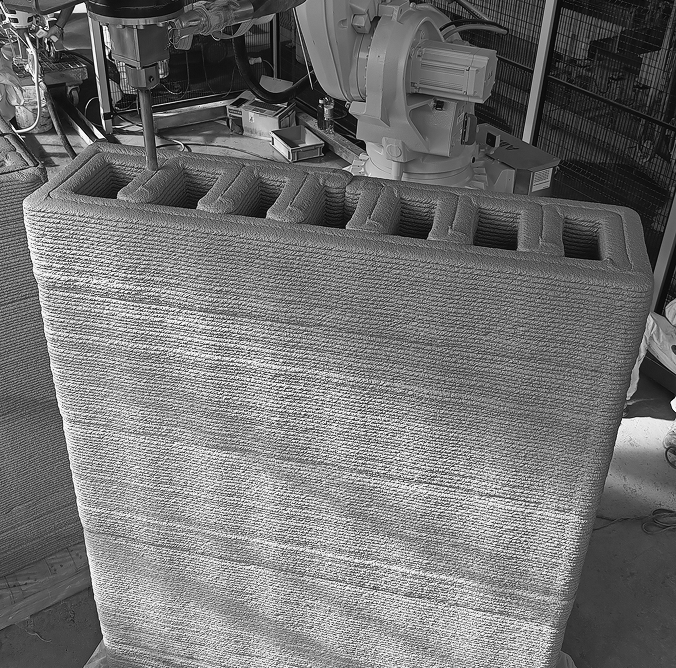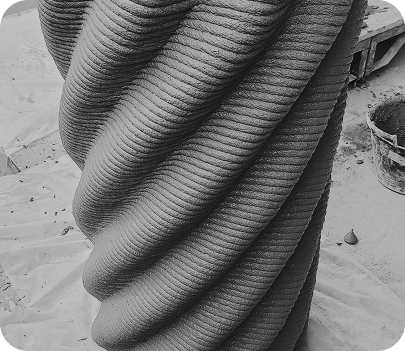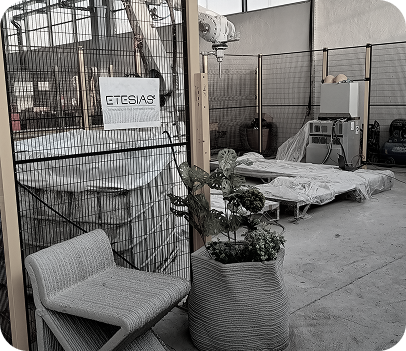SOLID AS THE FUTURE,
INNOVATIVE LIKE YOUR IDEAS
We design cutting-edge reinforced concrete for long-lasting constructions.
CONTACT USWHO WE ARE
OUR MISSION
TO BUILD
A multidisciplinary team aiming to innovate the construction industry by reducing environmental impact and
increasing efficiency through 3D printing of prefabricated reinforced concrete elements.

Increased productivity and sustainability:
+70% productivity, -50% environmental impact, and -30% waste with formwork-free 3D printing.

Reduced use of raw materials and energy savings:
Up to 50% savings in raw materials and 30% in energy through integrated process control.

Customization and smart technology:
Complex and customizable prefabricated elements to meet specific needs and ensure maintainability.
TECHNOLOGY AND INNOVATION
OUR TECHNOLOGY
ETESIAS technology uses additive manufacturing to create structural and non-structural concrete elements by sequentially depositing layers of material. This approach ensures:
Environmental sustainability: up to 50% less cement with equal performance.
Versatile production: complex and customizable shapes.
Flexibility: production in factory or on-site
Efficiency: reduced time and production costs.
Innovation and safety: robotic automation enhances safety, quality, and supports on-site labor.




WHAT WE OFFER
OUR SERVICES

3D Printing for Construction
Design and production of building components using additive manufacturing.

Computational and Parametric Design
Development of advanced geometries optimized for 3D printing.


Research and Development of Innovative Materials
Testing and creation of new materials and components for construction.


Engineering of Printing Processes
Optimization of machine codes and management of digital workflows.


Automation and Robotics
Configuration, control, and implementation of machinery and technologies for 3D printing.


Prototyping and Structural Testing
Validation of 3D printed components through experimental testing.

FAQS
FREQUENTLY ASKED QUESTIONS

What is 3D printing in the construction sector and how does it work?

What are the advantages of 3D printing in construction?
- Material savings: Up to 50% less cement compared to traditional methods.
- Lower CO₂ emissions: Reduced environmental impact.
- Design freedom: Create complex geometries without additional cost.
- Efficiency and speed: Faster construction with less manual labor required.

What types of projects can benefit from 3D printing?
- 3D printing is ideal for:
- Customized structures (urban furniture, architectural elements)
- Lightweight and sustainable constructions (housing modules, temporary infrastructures)
- Large-scale projects where speed and resource optimization are crucial

What materials can be used in 3D printing for construction?

What are the current limitations of 3D printing in construction?
- The main challenges include:
- Regulations: The technology is still evolving and requires dedicated standards.
- Scalability: Some constructions still require integration with traditional methods.
- Specialized materials: Research on more sustainable compounds is ongoing.

What services does Etesias offer in the field of 3D printing?
- Parametric and computational design for tailored solutions
- 3D printing of architectural elements and infrastructure
- Consulting and technological development to drive innovation in the construction sector
Want to learn more?
Explore all FAQs to clear up any doubts.
CONTACT US
OUR CONSULTING SERVICES
We create smart, customizable construction and design elements, fully leveraging the potential of additive manufacturing.



